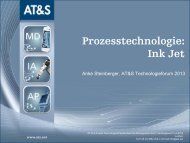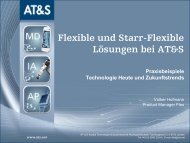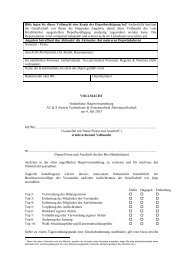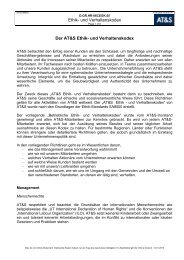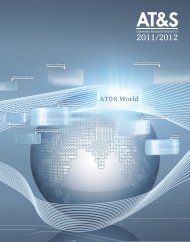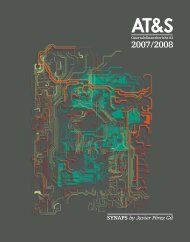AT&S World
AT&S World
AT&S World
Create successful ePaper yourself
Turn your PDF publications into a flip-book with our unique Google optimized e-Paper software.
eporting, regular reporting is made to the audit committee on<br />
risk management and activities of the internal audit (risk and<br />
audit report). The audit committee in turn reports to the other<br />
members of the Supervisory Board.<br />
The executives of AT&S as risk responsibles are responsible for<br />
identifying, analyzing, controlling and monitoring risks in their<br />
respective area. In addition, the local management of the plants<br />
is responsible for the implementation of the risk management<br />
process in their areas of responsibility. Risk management coordinators<br />
in the group companies assist the group function in<br />
the collection and transmission of risk information. In terms of<br />
an efficient organization according to the company size, the organizational<br />
servicing of the internal control system is designed<br />
accordingly.<br />
Based on business processes documented in the management<br />
manual, the related risks are described and assessed by the process<br />
responsibles for each main and sub-process. In the risk<br />
assessment, basically all potentially negative factors that jeopardize<br />
the achievement of the objectives of an organization or a<br />
process have to be documented by the process owner. The control<br />
objectives for the financial reporting are derived from existing<br />
risks and allocated to the categories existence (only actually existing<br />
and approved business transactions are processed), occurrence/period<br />
accrual (representation of business transactions in<br />
the correct period or timely processing), completeness (business<br />
transactions, assets and liabilities are recognized completely),<br />
measurement (business transactions were calculated using appropriate<br />
measurement methods or correctly), rights & obligations<br />
(The company has economic ownership of assets and liabilities<br />
are actual obligations of the company), presentation<br />
& disclosure (disclosure in the financial statements and other<br />
reports), correctness of business transactions/data and access<br />
restriction (access to IT systems is restricted to process responsibles).<br />
The documentation of the internal controls (business processes,<br />
risks, control measures and responsibles) is made principally<br />
in the form of control matrices, which are archived in a central<br />
management database. The accounting-related internal control<br />
system includes principles, procedures and measures to ensure<br />
the compliance of group accounting in terms of the control objectives<br />
described with financial reporting.<br />
The processes of accounting and group accounting are documented<br />
in separate process instructions. Basis for the group reporting<br />
are the respective local accounts, which are transformed into a<br />
group-wide uniform reporting. The individual pre-accounting<br />
processes are as far as possible uniformly designed across the<br />
Group Management Report 2010/11<br />
Group and are presented in a standardized documentation format.<br />
In addition to the group reporting, various local regulations<br />
have to be considered accordingly, resulting in additional<br />
requirements on the accounting processes.<br />
The principles of group accounting and reporting are set out in<br />
the group-wide “Group Accounting Manual”. This manual regulates<br />
the significant accounting and reporting requirements<br />
across the Group in a uniform manner. In addition to the basic<br />
presentations on the accounting of individual business transactions<br />
and measurement guidelines based on IFRS, options applied<br />
uniformly across the Group are dealt with in particular.<br />
As for scheduling, a timetable is set up for the entire internal<br />
and external reporting which, apart from report deadlines, also<br />
includes the planned dates for the meetings of the Supervisory<br />
Board and audit committee, as well as press conferences.<br />
At AT&S, the processes for group accounting and the preparation<br />
of the group management report are controlled by the Group Accounting/Group<br />
Finance department, which reports to the CFO.<br />
Laws, accounting standards and other announcements are continuously<br />
analyzed regarding the relevance and impact on the<br />
consolidated financial statements and other reporting requirements.<br />
The collection, current entry and accounting of the business<br />
transactions is performed in the manufacturing group companies<br />
mainly through a uniform and central software solution of<br />
SAP. The individual business transactions and measurements<br />
can be entered in accordance with the group-uniform IFRS, as<br />
well as in accordance with local accounting regulations, in order<br />
to comply with these different requirements. At individual<br />
subsidiaries, in particular due to the smaller size, other software<br />
solutions are applied, which also comply with the group reporting<br />
requirements and local regulations. The central reporting<br />
software Oracle Enterprise Performance Management System is<br />
used for consolidation and group reporting. Automatic interfaces<br />
have been established for the transition of accounting data from<br />
the primary system to the group reporting software.<br />
The internal financial reporting is made on a monthly basis, with<br />
the financial information of the subsidiaries being reviewed and<br />
analyzed at the group level by the Group Accounting department.<br />
The monthly budget/actual variance with corresponding comments<br />
on the plant results as well as the group result is reported<br />
internally to the executives of the Group and to the members of<br />
the Supervisory Board. At the end of the quarter, detailed reporting<br />
packages with all relevant accounting data on income statement,<br />
balance sheet, cash flow statement and the disclosures<br />
in the notes are submitted. These reporting packages form the<br />
113



